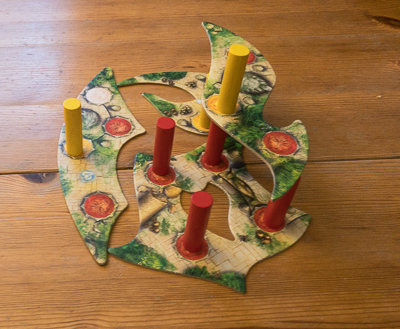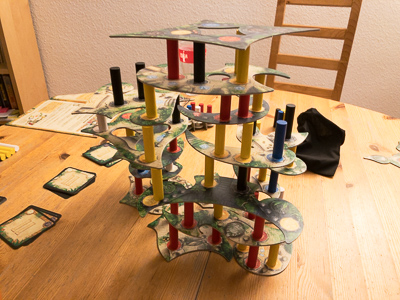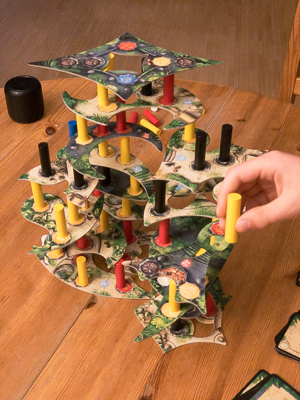

![[IMAGE]](../bilder/menara1.jpg) |
Author: Publisher: No. of Players: Awards: |
![[IMAGE]](../technik/box/rot/rot-5.gif) ![[IMAGE]](../technik/box/gelb/gelb-8.gif) ![[IMAGE]](../technik/box/grun/grun-7.gif) ![[IMAGE]](../technik/box/pink/pink-5.gif) ![[IMAGE]](../technik/box/blau/blau-8.gif) |
|
G@mebox author Ralf Togler writes about the game:
Menara, that's the former name of one of the southern provinces of Thailand. But it is also the Malaysian word for tower. And finally, Menara is the name for the new big family game from Zoch, designed by Oliver Richtberg. And the name says it all: The game takes place in a green hell (probably the Thai province), where explorers have found fragments of an ancient structure. These fragments have been identified as parts of an old temple. And now we players come into play, because someone had the weird idea that it should be possible to re-erect this old temple with the fragments. But which fragment fits to which placer? There are only strange glyphs and parts of the construction plans left. And thus doesn't make things easier...
Menara is a cooperative game. 1-4 players have to build up the temple from its ruins, but a collapse is always close. We just begin with a small floor, consisting out of 3 parts. Theese parts form the temple base and everything else must stand on these base tiles. But as said, there are only fragments left, and thus the floors aren't rectangular or circular. Quite the contrary, there are more holes and notches than there is base. The same applies to all other temple fragments that have to be placed on top of the base. What a mess!
 Things could still be easy, wouldn't there be columns that have to be placed between the different floors of the temple. And these columns come in five different colours. What colour we have to take is determined by the base and floor tiles. Only colour-matching columns can be used on the marked positions on the different levels of the temple. Now, the game would still be fairy easy, if you were allowed to build up whatever you want. But you are partly controlled by the various construction plans and – even more annoying – by your own resources of columns. Every player gets his own set of columns at the set-up, and after your turn you draw as many new, as you have used before. But you do it randomly from a bag. As a result, you can end up with columns of only one or two colours, no one fitting to the available spaces on the corrent floors of the temple.  Luckily enough, you are allowed to exchange two columns at the beginning of your turn. But then it is time to proof your worth: you must reveal a construction plan and fulfil the task shown on it. For example, it could be our task to place one, two, three or more columns. But there are also meaner tasks like moving columns from one space to another or moving a whole floor tile, independent, if there are columns on top of it or not. There are three different difficulty levels in the construction plans, but in the end we have to solve them all. So it is only a matter of time, when the more difficult tasks have to be mastered. As we can freely choose from the available construction plans, which difficulty level we want to solve in our turn, we can use clever tactics. If there are a lot of free spaces for columns for example and we have a big choice of different colours of columns, we can risk to take more difficult tasks, because the number of columns to be placed will be higher than in easier tasks. But beware! If you continously take the easier tasks, you will have to solve all the difficult tasks in the end game, when the temple will be already unstable. Whenever the last free space for a column on a floor or base tile is covered by a column, a new floor is taken from the storage, and must be placed on top of the free columns. As a result, the temple grows in height, which looks great, but does not really contribute to the structure's stability.  But what happens, if a player fails to fulfil the drawn construction plan? Well, it doesn't end the game immediately, but it dramitically changes the victory conditions, because it increases the number of levels the temple has to reach. With progressing time, it becomes more and more difficult to place the columns and floor tiles. Instability is not a foreign word for Menara players. But finally the last construction plan is taken, or the last column is drawn from the supply or the last temple floor has been placed. Then the game ends. But victory is not mandatory: We still have to fulfil the required number of floors. And woe! If any temple floor collapses, the game ends immediately, usually without meeting the necessary requirements to win the game.... To my mind, Menara is a wonderful game for the whole family. Dexterity, clever selections from the available construction plans and calmness is asked to master the game. It is definitely no game of speed. But you will see that during the whole game you share the thrill with your fellow players. All for one and one for all! To see the temple growing in height is a feat for the eyes, and if you are skilful enough, you will be amply rewarded by a pretty to watch construction. If you are fed up with Jenga, and you like the stacking genre, Menara should be your next game. Maybe we all should become excavators in our next live... | ||
|
| ||

|
|

|
|
| ||
|
Impressum / Contact Info / Disclaimer Kulkmann@aol.com
Copyright © 2018 Ralf Togler & Frank Schulte-Kulkmann, Essen, Germany | ||